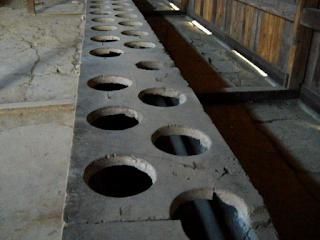JPEF Education Manager Jonathan Furst recently returned from a trip to Prague for the ELMLE conference European International School middle-school educators. The trip included a pre-conference tour of the Terezin ghetto, and was followed by a trip to Auschwitz-Birkenau in Poland.
Read Part I here.
Read Part II here.
Following the trip to Terezin, I realized that my journey would be incomplete – I would be incomplete – until I went to the heart of the beast: Auschwitz-Birkenau. I arranged to visit a few days after the conference.
The first thing to know about Auschwitz-Birkenau is that it is cold. On the day I went, the temperature was -30˚ Celsius on a windless day. Even in thermals and a heavy coat I was chilled. I took my shoes and gloves off to pray for 20 minutes – days later, my hands were still chapped and my feet felt painfully cold. How anyone survived there at all is beyond my understanding.
Bikenau is one of the most desolate places on earth. 1.1 million people were murdered* – more than a thousand human deaths occurred every day for years. Truly a death machine.
They say that no birds and no animals ever strayed near, and no plants grew there during the Holocaust. And I believe it. The ground is barren – the ruins of barracks (destroyed by the Nazis’ attempt to erase evidence of their crimes) lie behind stretches of 13-foot high barbed wire. Electrified barbed wire: something about that still stuns and enrages me, the mere fact that someone could conceive of it.
My overall reaction, though, wasn’t rage. Or even shock or sadness (although I felt all of those). Unexpectedly, I felt a defiant pride. The Reich that was supposed to last a thousand years didn’t even last twenty. But we still live on, after four thousand years on this earth. “You’re gone,” I thought, “and we are here”.
And even here there was resistance – even the armed kind. Very few people have ever heard of the Auschwitz-Birkenau Revolt, when a group of Jews overcame the guards and destroyed one of the crematoria. (Tiny amounts of gunpowder were smuggled into the Birkenau death camp by women who worked in the munitions factory in Auschwitz). The ruins of the crematoria are simultaneously horrifying and inspiring to see in person.
And then there were the latrines. Dysentery was rampant, yet inmates who were in a constant state of diarrhea were allowed to go to the bathroom only at two or three fixed times of the day, and for no more than a few minutes. The latrine is a vast barn with hundreds of crude holes placed over a trench, side-by-side and back-to-back, to be used by 32,000 people a day. It’s the little details like this that bring the horror home.
The smell must have been asphyxiating. In an attempt to humiliate intellectuals and other ‘troublemakers’, the Germans would assign them the task of cleaning out the filth. But the job of ‘Scheissekommando’ was secretly considered an opportunity instead of a humiliation. Not only could the enslaved workers relieve themselves as often as they needed, but the guards would refuse to go in do to the stench, so this was one of the few places where Jews could talk without being overheard. Here is where the resistance organized and made plans.
Even in the most desperate conditions such as this, one could unearth stories of resistance. Most of them will never be known, but some still survive. To find out more, visit the following links:
- Information about incidents of resistance from the Auschwitz-Birkenau Memorial and Museum site.
- Auschwitz resistance at iearn.org.
All photos and videos taken by Jonathan Furst during his trip. Copyright 2012 JPEF.
Part 1 — Insights from the Prague International Schools Conference
Part 2 — Terezin: Healing Through Art and Storytelling




